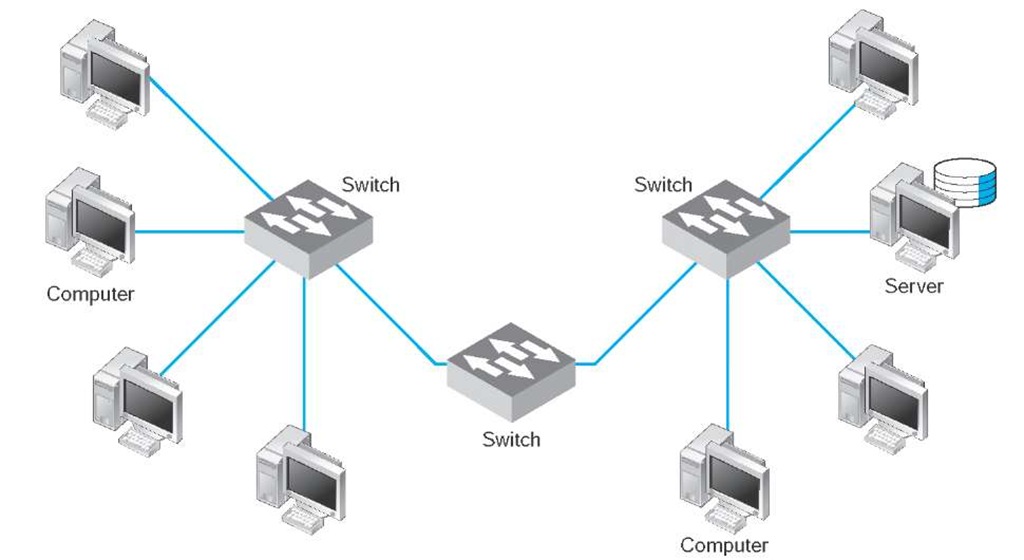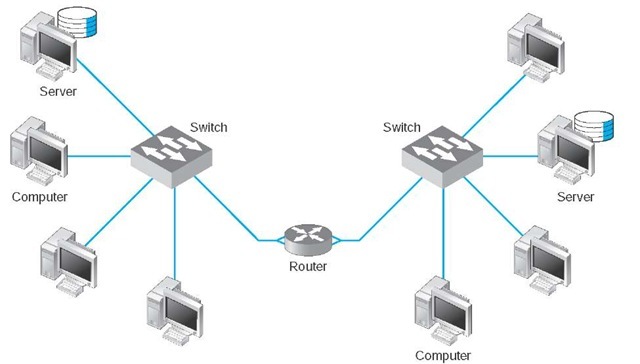There are two basic components to a BN: the network cable and the hardware devices that connect other networks to the BN. The cable is essentially the same as that used in LANs, except that it is often fiber optic to provide higher data rates. The hardware devices can be computers or special-purpose devices that just transfer messages from one network to another. These include switches, routers, and gateways (Figure 8.1).
Switches
Most switches operate at the data link layer. They connect two or more network segments that use the same data link and network protocol. They understand only data link layer protocols and addresses. They may connect the same or different types of cable. These are the same layer-2 switches discussed in next topic in that they use the data link layer address to forward packets between network segments (Figure 8.2). They learn addresses by reading the source and destination addresses.
Routers
Routers operate at the network layer. Routers connect two or more network segments that use the same or different data link protocols but the same network protocol. They may connect the same or different types of cable. Routers are the "TCP/IP gateways" that we first introduced in next topic. Routers strip off the data link layer packet, process the network layer packet, and forward only those messages that need to go to other networks on the basis of their network layer address (Figure 8.3).
|
Device |
Operates At |
Packets |
Physical Layer |
Data Link Layer |
Network Layer |
|
Switch |
Data link layer |
Filtered using data link layer addresses |
Same or different |
Same |
Same |
|
Router |
Network layer |
Routed using network layer addresses |
Same or different |
Same or different |
Same |
|
Gateway |
Network layer |
Routed using network layer addresses |
Same or different |
Same or different |
Same or different |
Figure s.1 Backbone network devices
Figure s.2 Use of switches to connect local area network segments
Routers may be special purpose devices or special network modules in other devices (e.g., wireless access points for home use often include a built-in router). In general, they perform more processing on each message than switches and therefore operate more slowly.
One major feature of a router is that it can choose the "best" route between networks when there are several possible routes between them. Because a router knows its own location, as well as the packet’s final destination, it looks in a routing table to identify the best route or path.
Figure s.3 Use of routers to connect local area networks
One other important difference between a router and a switch is that a router processes only those messages that are specifically addressed to it. Switches process all messages that appear on the network and forward them to the appropriate network on the basis of their data link layer address. Switches simply forward the message unchanged to the other network. In contrast, because routers operate at the network layer, the router’s data link layer must first recognize that the incoming message is specifically addressed to the router at the data link layer level before the message is passed to the network layer for processing. The router will then process the message by building an entirely new data link layer packet, then transmit it to the other network.
The router attempts to make no changes to the network layer packet and user data it receives. (As noted previously, it creates a new data link layer packet.) Sometimes, however, changes are needed, such as when the maximum data link layer packet size on one network is different from another, which forces the router to split a message into several smaller messages for transmission.
Gateways
Gateways operate at the network layer and use network layer addresses in processing messages. Gateways are more complex than switches or routers because they are the interface between two or more dissimilar networks. Gateways connect two or more networks that use the same or different (usually different) data link and network protocols.
Figure s.4 Use of gateways to connect local area networks and a mainframe
They may connect the same or different types of cable. Some gateways operate at the application layer as well. Gateways process only those messages explicitly addressed to them (i.e., using their data link layer address) and route those messages that need to go to other networks (Figure 8.4).
Gateways translate one network layer protocol into another, translate data link layer protocols, and open sessions between application programs, thus overcoming both hardware and software incompatibilities. A gateway may be a stand-alone computer with several NICs and special software or a front-end processor connected to a mainframe computer.
One of the most common uses of gateways is to enable LANs that use TCP/IP and Ethernet to communicate with mainframes that use other protocols. In this case, the gateway converts the microcomputer LAN transmissions into a transmission that looks like it came from a terminal. The gateway provides both the basic system interconnection and the necessary translation between the protocols in both directions. Without this gateway on the LAN, each microcomputer would have to have its own hardware and software in addition to the TCP/IP and Ethernet hardware and software (e.g., software to make the microcomputer act like a terminal). The gateway eliminates the need for additional hardware for the microcomputer, and it requires only one connection to the client computer because all data are sent through the LAN.
Building a tcp/ip Gateway
MANAGEMENT FOCUS
Transco is the United Kingdom’s largest utility company, responsible for gas transfer across a network of 200,000 miles of pipeline and serving the needs of more than 20 million commercial, industrial, and domestic consumers. Transco was formed from the merger of dozens of regional gas boards, and therefore inherited a network composed of a mixture of technologies, many of which were not compatible.
Transco concluded that its new network should be founded on TCP/IP. With many of the Transco sites being in remote outstation locations, the idea also emerged to create a satellite-based WAN carrying IPtraffic, thereby removing the high costs and inflexibility of traditional telephone or cable systems.
The outstation locations had a large number of serial-based control and communications devices installed over the years. These were perfectly workable pieces of equipment for which there was no reason to replace. However, the equipment was serial-based with no Ethernet connection and was not compatible with IP.
Therefore, an intermediate communications device was developed to translate the proprietary serial protocol into standard IP-based data. Engineers modified a matchbox-sized Lantronix industrial device server, the Micro IAP, which provides IP and a Web server, thus removing the need for the Transco engineers to write a TCP/IP driver. It simply plugged onto a connector designed as part of the Transco device, providing the unit with TCP/IP connectivity at a stroke.
After the Transco engineers had thoroughly tested the prototype device with the legacy out-stations using the proposed protocol, the Micro IAP was added, making the unit Ethernet-enabled and so able to connect into the satellite WAN. Results over the Transco satellite IP system were ”outstanding,” according to Keith Hand, a Transco telemetry engineer.
A Caution
One warning is in order. The terminology used in the marketplace may differ substantially from that in the preceding discussion. Many new types of switches, routers, and gateways are being developed, so that one vendor’s "switch" may actually provide the functions of a "router." Layer-3 switches function in the same way as layer-2 switches discussed previously, but they switch messages on the basis of their network layer address (usually IP address). These switches provide the best of both switches and routers. They can be used in place of routers but provide the benefits of traditional layer-2 switches: much faster transmission and more simultaneously active ports than routers.
Multiprotocol routers can understand several different network layer protocols. If they receive a message in one protocol, they process it and send it out using the same protocol. Some vendors’ multiprotocol routers translate between different network layer protocols (usually TCP/IP and IPX/SPX) so, technically, they are gateways.



